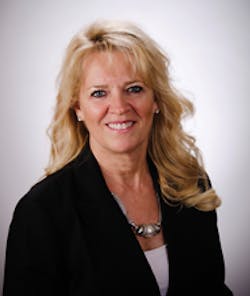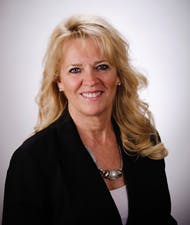Chatting about whitening: Sharon Zastrow shares her insights about trends in teeth whitening
Chatting about whitening
Sharon Zastrow shares her insights about trends in teeth whitening
Sharon Zastrow, RDH, BS, EF, is a practicing clinical hygienist, author, presenter, and meeting planner for dental professionals. She started her career path as a dental assistant, which was a stepping stone to her real passion-dental hygiene. Since then, she has taken extensive training in expanded functions periodontal therapy, anesthesia, suture placement, whitening, laser therapy, and countless hours of continuing education to practice at a level of excellence.
Sharon owns a temporary dental hygiene service and is now a hygiene success coach for BCS Leadership, a dental practice coaching firm in Phoenix Arizona. Sharon combines her experience, knowledge, and passion for dental hygiene to inspire dental teams to reach their pinnacle for providing exceptional dental care.
She recently sat down with RDH to discuss trends in whitening services offered by dental offices.RDH: Consumers still search for what they believe will be more cost effective methods for whitening teeth outside of the dental setting. What do you recommend for dental hygienists to clarify for patients who indicate that they desire whiter teeth?"
RDH:Consumers still search for what they believe will be more cost effective methods for whitening teeth outside of the dental setting. What do you recommend for dental hygienists to clarify for patients who indicate that they desire whiter teeth?
Zastrow:Consumers associate white teeth with confidence, attractiveness, and overall good health. It is a misnomer that whiter teeth are the same as healthy teeth since tooth color has very little to do with the health of the tooth. The consumer perception, though, is that white teeth equal a healthy mouth, and perception is reality.
Whitening is a cosmetic procedure, as well as a great marketing tool for the practice. Dental hygienists can clarify the differences between over-the-counter options and in-office whitening by first determining the consumer's lifestyle and budget. There are over-the-counter options that may be effective. However, challenges with proper placement of the product, the amount of time it takes for the product to work, and the fact it may require multiple purchases of the product that can be cost prohibitive can be deterrents for over-the-counter products.
The advantage of in-office whitening is that the consumer can usually achieve several shades lighter in one visit, and it often lasts a significant amount of time, depending upon lifestyle. This option may also include a custom tray take-home product, or the custom trays may be an additional cost. Having the custom trays after the in-office whitening makes it easy for the consumer to continue to maintain a whiter, brighter smile.
Consumers tend to believe what they see in commercials, and what they don't understand are the limits of over-the-counter products. For example, whitening toothpaste doesn't stay in the mouth long enough to have a "true" whitening effect. It's the abrasiveness of the product that potentially eliminates some of the staining that may create a "lighter" appearance. But it's not truly whitening.
Consumers are led to believe that over-the-counter products are as effective as professional products, and it is important that the hygienist is able to distinguish the differences between over-the-counter and professional products to provide the consumer with the information to make an informed decision.
This requires research of both over-the-counter products and professional whitening so that the hygienist can speak authoritatively on the benefits of professional in-office versus over-the-counter whitening. Creating value regarding in-office whitening is key. Consumers will buy value and when the hygienist creates that value in the in-office whitening systems-and shares the potential uncertainty of the results of over-the-counter products in the amount of product needed, compliance, and cost-the consumer will most likely choose the professional option.
RDH: One of PennWell's electronic newsletters, the Product Navigator, recently published an article advocating how dental hygienists should carefully outline all whitening procedures available in an office. What types of options would you suggest discussing with patients? RDH: One of PennWell's electronic newsletters, the Product Navigator, recently published an article advocating how dental hygienists should carefully outline all whitening procedures available in an office. What types of options would you suggest discussing with patients?
Zastrow: Today's consumers want options, and fortunately there are several. For those who are compliant and want to control the frequency of whitening, a custom home bleaching system such as Philips Zoom DayWhite or NiteWhite would be beneficial. This allows the consumer to have custom trays made. After they have achieved the lightness desired in seven to 14 days, the trays can be re-used periodically for touch ups with the frequency determined by lifestyle, such as coffee, tea, wine, and other staining food consumption.
Philips also offers two other in-office systems for consumers who may not be compliant with the process of home whitening and want more immediate results. One of my favorites is the Philips Zoom WhiteSpeed. This system is light activated with three 15-minute intervals and can achieve up to eight shades lighter in less than an hour. I loved the system so much when it came out I bought one myself to use in the office because I couldn't wait for the dentist to make up his mind.
An economical in-office whitening procedure is the Philips Zoom QuickPro, which is a varnish applied on the teeth that is brushed off after approximately 30 minutes. This will lighten the teeth up to four shades. However, the shade increase is not as dramatic as the Philips Zoom WhiteSpeed lamp, but is in line with the cost.
RDH:Do you have any suggestions for dental hygienists who wish to incorporate a discussion about teeth whitening as part of an overall educational message regarding complete oral health? Some dental professionals are frustrated by the separation of whitening treatment from the opportunity to focus on overall oral health" RDH: Do you have any suggestions for dental hygienists who wish to incorporate a discussion about teeth whitening as part of an overall educational message regarding complete oral health? Some dental professionals are frustrated by the separation of whitening treatment from the opportunity to focus on overall oral health.
Zastrow: Hygienists can capitalize on the consumer's perception that white teeth go hand in hand with overall optimum oral health, enrolling the patient in whitening as part of the oral health care experience-the icing on the cake if you will. Having whitening included in a program of complete oral health for the consumer should be part of the treatment presentation.
This solidifies for the consumer that whiter teeth are the bonus at the end of treatment. Who doesn't want to smile with confidence, and we all know that a bright white smile is a great way to be noticed.
Hygienists can also create a simple questionnaire for consumers to find out their dental IQ on whitening. These questions open the door to discussions about whitening and how it is included in the overall treatment plan to obtain optimum oral health. These questions include:
• Is there anything about your smile you would change?
• Would you like to have whiter teeth?
• On a scale of 1 to 10, 10 being most important, how important is it to you to have whiter teeth?
• What do you consider a comfortable price range for whiter teeth?
• What are your expectations for having your teeth whitened? RDH

